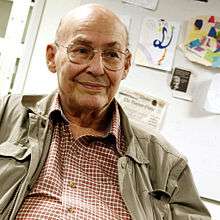Marvin Minsky
Marvin Lee Minsky (August 9, 1927 – January 24, 2016) was an American cognitive scientist concerned largely with research of artificial intelligence (AI), co-founder of the Massachusetts Institute of Technology's AI laboratory, and author of several texts concerning AI and philosophy.[12][13][14][15]
Minsky received many accolades and honors, such as the 1969 Turing Award.
Biography
Marvin Lee Minsky was born in New York City, to an eye surgeon father, Henry, and to a mother, Fannie (Reiser), who was a Zionist activist.[15][16][17] His family was Jewish. He attended the Ethical Culture Fieldston School and the Bronx High School of Science. He later attended Phillips Academy in Andover, Massachusetts. He then served in the US Navy from 1944 to 1945. He received a B.A. in mathematics from Harvard University in 1950 and a Ph.D. in mathematics from Princeton University in 1954. His doctoral dissertation was titled "Theory of neural-analog reinforcement systems and its application to the brain-model problem."[18][19][20] He was a Junior Fellow of the Harvard Society of Fellows from 1954-1957.[21][22]
He was on the MIT faculty from 1958 to his death. He joined the staff at MIT Lincoln Laboratory in 1958, and a year later he and John McCarthy initiated what is, as of 2019, named the MIT Computer Science and Artificial Intelligence Laboratory.[23][24] He was the Toshiba Professor of Media Arts and Sciences, and professor of electrical engineering and computer science.
Contributions in computer science

Minsky's inventions include the first head-mounted graphical display (1963)[25] and the confocal microscope[2][note 1] (1957, a predecessor to today's widely used confocal laser scanning microscope). He developed, with Seymour Papert, the first Logo "turtle". Minsky also built, in 1951, the first randomly wired neural network learning machine, SNARC.
In 1962, Minsky published a (7,4) Turing machine and proved it universal. It was the simplest known universal Turing machine until Stephen Wolfram's (2,3) Turing machine was proven to be universal in 2007.[26]
Minsky wrote the book Perceptrons (with Seymour Papert), attacking the work of Frank Rosenblatt, which became the foundational work in the analysis of artificial neural networks. This book is the center of a controversy in the history of AI, as some claim it to have had great importance in discouraging research of neural networks in the 1970s, and contributing to the so-called "AI winter".[27] He also founded several other AI models. His book A framework for representing knowledge created a new paradigm in programming. While his Perceptrons is now more a historical than practical book, the theory of frames is in wide use.[28] Minsky also wrote of the possibility that extraterrestrial life may think like humans, permitting communication.[29]
In the early 1970s, at the MIT Artificial Intelligence Lab, Minsky and Papert started developing what came to be known as the Society of Mind theory. The theory attempts to explain how what we call intelligence could be a product of the interaction of non-intelligent parts. Minsky says that the biggest source of ideas about the theory came from his work in trying to create a machine that uses a robotic arm, a video camera, and a computer to build with children's blocks. In 1986, Minsky published The Society of Mind, a comprehensive book on the theory which, unlike most of his previously published work, was written for the general public.
 General view
General view the Belgrade Hand
the Belgrade Hand
In November 2006, Minsky published The Emotion Machine, a book that critiques many popular theories of how human minds work and suggests alternative theories, often replacing simple ideas with more complex ones. Recent drafts of the book are freely available from his webpage.[30]
Role in popular culture
Minsky was an adviser[31] on Stanley Kubrick's movie 2001: A Space Odyssey; one of the movie's characters, Victor Kaminski, was named in Minsky's honor.[32] Minsky is mentioned explicitly in Arthur C. Clarke's derivative novel of the same name, where he is portrayed as achieving a crucial break-through in artificial intelligence in the then-future 1980s, paving the way for HAL 9000 in the early 21st century:
In the 1980s, Minsky and Good had shown how artificial neural networks could be generated automatically—self replicated—in accordance with any arbitrary learning program. Artificial brains could be grown by a process strikingly analogous to the development of a human brain. In any given case, the precise details would never be known, and even if they were, they would be millions of times too complex for human understanding.[33]
Personal life

In 1952, Minsky married pediatrician Gloria Rudisch; together they had three children.[34] Minsky was a talented improvisational pianist[35] who published musings on the relations between music and psychology.
Opinions
Minsky was an atheist,[36] a signatory to the Scientists' Open Letter on Cryonics.[37]
He was a critic of the Loebner Prize for conversational robots,[38] and argued that a fundamental difference between humans and machines was that while humans are machines, they are machines in which intelligence emerges from the interplay of the many unintelligent but semi-autonomous agents that comprise the brain.[39] He argued that "somewhere down the line, some computers will become more intelligent than most people," but that it was very hard to predict how fast progress would be.[40] He cautioned that an artificial superintelligence designed to solve an innocuous mathematical problem might decide to assume control of Earth's resources to build supercomputers to help achieve its goal,[41] but believed that such negative scenarios are "hard to take seriously" because he felt confident that AI would go through a lot of testing before being deployed.[42]
Death
In January 2016 Minsky died of a cerebral hemorrhage, at the age of 88.[43] Minsky was a member of Alcor Life Extension Foundation's Scientific Advisory Board.[44] Alcor will neither confirm nor deny whether Minsky was cryonically preserved.[45]
Association with Jeffrey Epstein
Minsky received a $100,000 research grant from Jeffrey Epstein in 2002, four years before Epstein's first arrest for sex offenses; it was the first from Epstein to MIT. Minsky received no further research grants from him.[46][47]
Minsky organized two academic symposia on Epstein's private island Little Saint James, one in 2002 and another in 2011, after Epstein was a registered sex offender.[48] Virginia Guiffre testified in a 2015 deposition in her defamation lawsuit against Epstein associate Ghislaine Maxwell that Maxwell directed her to have sex with Minsky among others. There is no independent corroboration of the sex allegations, and there has been no lawsuit against Minsky's estate.[49] Minsky's widow, Gloria Rudisch, says that he could not have had sex with any of the women at Epstein's residences, as they were always together during all of the visits to Epstein's residences.[50][51]
Bibliography (selected)
- 1967 – Computation: Finite and Infinite Machines, Prentice-Hall
- 1986 – The Society of Mind
- 2006 – The Emotion Machine: Commonsense Thinking, Artificial Intelligence, and the Future of the Human Mind
Awards and affiliations
Minsky won the Turing Award (the greatest distinction in computer science)[39] in 1969, the Golden Plate Award of the American Academy of Achievement in 1982,[52] the Japan Prize in 1990, the IJCAI Award for Research Excellence for 1991, and the Benjamin Franklin Medal from the Franklin Institute for 2001.[53] In 2006, he was inducted as a Fellow of the Computer History Museum "for co-founding the field of artificial intelligence, creating early neural networks and robots, and developing theories of human and machine cognition."[54] In 2011, Minsky was inducted into IEEE Intelligent Systems' AI Hall of Fame for the "significant contributions to the field of AI and intelligent systems".[55][56] In 2014, Minsky won the Dan David Prize for "Artificial Intelligence, the Digital Mind".[57] He was also awarded with the 2013 BBVA Foundation Frontiers of Knowledge Award in the Information and Communication Technologies category.[58]
Minsky was affiliated with the following organizations:
- United States National Academy of Engineering[25]
- United States National Academy of Sciences[25]
- Extropy Institute's Council of Advisors[59]
- Alcor Life Extension Foundation's Scientific Advisory Board[44]
- kynamatrix Research Network's Board of Directors[60]
Media appearances
- Future Fantastic (1996)
- Machine Dreams (1988)
Notes
- The patent for Minsky's Microscopy Apparatus was applied for in 1957, and subsequently granted US Patent Number 3,013,467 in 1961. According to his published biography on the MIT Media Lab webpage, "In 1956, when a Junior Fellow at Harvard, Minsky invented and built the first Confocal Scanning Microscope, an optical instrument with unprecedented resolution and image quality".
References
- Minsky, Marvin (1961). "Steps toward Artificial Intelligence" (PDF). Proceedings of the IRE. 49: 8–30. CiteSeerX 10.1.1.79.7413. doi:10.1109/JRPROC.1961.287775.
- Minsky, Marvin (1988). "Memoir on inventing the confocal scanning microscope". Scanning. 10 (4): 128–138. doi:10.1002/sca.4950100403.
- Pesta, A (March 12, 2014). "Looking for Something Useful to Do With Your Time? Don't Try This". WSJ. Retrieved March 24, 2014.
- Hillis, Danny; McCarthy, John; Mitchell, Tom M.; Mueller, Erik T.; Riecken, Doug; Sloman, Aaron; Winston, Patrick Henry (2007). "In Honor of Marvin Minsky's Contributions on his 80th Birthday". AI Magazine. 28 (4): 109. doi:10.1609/aimag.v28i4.2064.
- Papert, Seymour; Minsky, Marvin Lee (1988). Perceptrons: an introduction to computational geometry. Cambridge, Massachusetts: MIT Press. ISBN 978-0-262-63111-2.
- Minsky, Marvin Lee (1986). The Society of Mind. New York: Simon and Schuster. ISBN 978-0-671-60740-1. The first comprehensive description of the Society of Mind theory of intellectual structure and development. See also The Society of Mind (CD-ROM version), Voyager, 1996.
- Minsky, Marvin Lee (2007). The Emotion Machine: Commonsense Thinking, Artificial Intelligence, and the Future of the Human Mind. New York: Simon & Schuster. ISBN 978-0-7432-7664-1.
- "Elected AAAI Fellows". www.aaai.org.
- Marvin Lee Minsky at the Mathematics Genealogy Project
- Marvin Lee Minsky at the AI Genealogy Project.
- "Personal page for Marvin Minsky". web.media.mit.edu. Retrieved June 23, 2016.
- Marvin Minsky at DBLP Bibliography Server

- List of publications from Microsoft Academic
- "Google Scholar". scholar.google.com.
- Winston, Patrick Henry (2016). "Marvin L. Minsky (1927-2016)". Nature. 530 (7590): 282. Bibcode:2016Natur.530..282W. doi:10.1038/530282a. PMID 26887486.
- Swedin, Eric Gottfrid (August 10, 2005). Science in the Contemporary World: An Encyclopedia. ABC-CLIO. p. 188 – via Internet Archive.
marvin minsky jewish.
- https://www.theguardian.com/technology/2016/feb/03/marvin-minsky-obituary
- https://catalog.princeton.edu/catalog/SCSB-4802106
- Minsky, Marvin Lee (1954). Theory of Neural-Analog Reinforcement Systems and Its Application to the Brain Model Problem (PhD thesis). Princeton University. OCLC 3020680. ProQuest 301998727.
- Hillis, Danny; McCarthy, John; Mitchell, Tom M.; Mueller, Erik T.; Riecken, Doug; Sloman, Aaron; Winston, Patrick Henry (2007). "In Honor of Marvin Minsky's Contributions on his 80th Birthday". AI Magazine. 28 (4): 103–110. Retrieved November 24, 2010.
- Society of Fellows, Listed by Term
- "Marvin Minsky, Ph.D. Biography and Interview". www.achievement.org. American Academy of Achievement.
- Horgan, John (November 1993). "Profile: Marvin L. Minsky: The Mastermind of Artificial Intelligence". Scientific American. 269 (5): 14–15. Bibcode:1993SciAm.269e..35H. doi:10.1038/scientificamerican1193-35.
- Rifkin, Glenn (January 28, 2016). "Marvin Minsky, pioneer in artificial intelligence, dies at 88". The Tech. MIT. Retrieved July 20, 2017.
- "Brief Academic Biography of Marvin Minsky". Web.media.mit.edu. Retrieved January 26, 2016.
- Wolfram, Stephen (2016). Idea Makers: Personal Perspectives on the Lives & Ideas of Some Notable People. Wolfram Media. p. 140. ISBN 978-1-5795-5-003-5.
- Olazaran, Mikel (August 1996). "A Sociological Study of the Official History of the Perceptrons Controversy". Social Studies of Science. 26 (3): 611–659. doi:10.1177/030631296026003005. JSTOR 285702.
- "Minsky's frame system theory". Proceedings of the 1975 workshop on Theoretical issues in natural language processing – TINLAP '75. 1975. pp. 104–116. doi:10.3115/980190.980222.
- Minsky, Marvin (April 1985). "Communication with Alien Intelligence". Byte. Vol. 10 no. 4. Peterborough, New Hampshire: UBM Technology Group. p. 127. Retrieved July 30, 2019.
- "Marvin Minsky's Home Page". web.media.mit.edu.
- For more, see this interview, "Archived copy". Archived from the original on June 16, 2012. Retrieved May 11, 2014.CS1 maint: archived copy as title (link)
- "AI pioneer Marvin Minsky dies aged 88". BBC News. January 26, 2016. Retrieved January 28, 2016.
- Clarke, Arthur C. 2001: A Space Odyssey. Hutchinson, UK
New American Library, US. ISBN 0-453-00269-2. - "R.I.P. Marvin Minsky". Washington Post. January 26, 2016. Retrieved January 28, 2016.
- "Obituary: Marvin Minsky, 88; MIT professor helped found field of artificial intelligence". Boston Globe. January 26, 2016. Retrieved January 28, 2016.
- Lederman, Leon M.; Scheppler, Judith A. (2001). "Marvin Minsky: Mind Maker". Portraits of Great American Scientists. Prometheus Books. p. 74. ISBN 9781573929325.
Another area where he "goes against the flow" is in his spiritual beliefs. As far as religion is concerned, he's a confirmed atheist. "I think it [religion] is a contagious mental disease. ... The brain has a need to believe it knows a reason for things.
- "SCIENTISTS' OPEN LETTER ON CRYONICS". The Science of Cryonics. Biostasis.com. March 19, 2004. Retrieved May 6, 2020.
- Salon.com Technology |Artificial stupidity Archived June 30, 2006, at the Wayback Machine
- "Marvin Minsky, Pioneer in Artificial Intelligence, Dies at 88". The New York Times. January 25, 2016. Retrieved January 25, 2016.
- "For artificial intelligence pioneer Marvin Minsky, computers have soul". Jerusalem Post. May 13, 2014. Retrieved January 27, 2016.
- Russell, Stuart J.; Norvig, Peter (2003). "Section 26.3: The Ethics and Risks of Developing Artificial Intelligence". Artificial Intelligence: A Modern Approach. Upper Saddle River, N.J.: Prentice Hall. ISBN 978-0137903955.
Similarly, Marvin Minsky once suggested that an AI program designed to solve the Riemann Hypothesis might end up taking over all the resources of Earth to build more powerful supercomputers to help achieve its goal.
- Achenbach, Joel (January 6, 2016). "Marvin Minsky, an architect of artificial intelligence, dies at 88". Washington Post. Retrieved January 27, 2016.
- Pearson, Michael (January 26, 2016). "Pioneering computer scientist Marvin Minsky dies at 88". CNN. Retrieved April 7, 2016.
- "Alcor Scientific Advisory Board". Alcor. January 14, 2016. Archived from the original on January 14, 2016. Retrieved April 7, 2016.
- admin (January 27, 2016). "Official Alcor Statement Concerning Marvin Minsky". Alcor News. Alcor Life Extension Foundation. Retrieved May 6, 2020.
- Subbaraman, Nidhi (January 10, 2020). "MIT review of Epstein donations finds "significant mistakes of judgment"". Nature. doi:10.1038/d41586-020-00072-x.
- Report Concerning Jeffrey Epstein's Interactions with the Massachusetts Institute Of Technology (PDF), pp. 9, 15
- "AI pioneer accused of having sex with trafficking victim on Jeffrey Epstein's island". The Verge. Retrieved August 8, 2019.
- Briquelet, Kate; et al. (September 16, 2019). "Jeffrey Epstein Accuser Names Powerful Men in Alleged Sex Ring". The Daily Beast. Retrieved August 8, 2019.
- Carlistle, Madeline; Mansoor, Sanya. "The Jeffrey Epstein Investigation Continues After His Death. Here's Who Else Could Be Investigated". Time.
Minsky’s widow, Gloria Rudisch, denied he had sex with Giuffre or any other girls
- "Jeffrey Epstein's alleged 'sex slave' reveals the men she claims she was forced to sleep with". New York Post. Retrieved August 8, 2019.
- "Golden Plate Awardees of the American Academy of Achievement". www.achievement.org. American Academy of Achievement.
- Marvin Minsky – The Franklin Institute Awards – Laureate Database Archived May 26, 2011, at the Wayback Machine. Franklin Institute. Retrieved on March 25, 2008.
- "Marvin Minsky: 2006 Fellow". Computer History Museum. Archived from the original on March 29, 2015. Retrieved July 30, 2019.
- "AI's Hall of Fame" (PDF). IEEE Intelligent Systems. 26 (4): 5–15. 2011. doi:10.1109/MIS.2011.64.
- "IEEE Computer Society Magazine Honors Artificial Intelligence Leaders". DigitalJournal.com. August 24, 2011. Retrieved September 18, 2011. Press release source: PRWeb (Vocus).
- "Dan David prize 2014 winners". May 15, 2014. Retrieved May 20, 2014.
- "MIT artificial intelligence, robotics pioneer feted: Award celebrates Minsky's career". BostonGlobe.com. August 24, 2011. Retrieved January 18, 2014.
- "Extropy Institute Directors & Advisors".
- "kynamatrix Research Network : About". www.kynamatrix.org. Retrieved February 9, 2018.
External links
| Wikimedia Commons has media related to Marvin Minsky. |
| Wikiquote has quotations related to: Marvin Minsky |
- Oral history interview with Marvin Minsky at Charles Babbage Institute, University of Minnesota, Minneapolis. Minsky describes artificial intelligence (AI) research at the Massachusetts Institute of Technology (MIT). Topics include: the work of John McCarthy; changes in the MIT research laboratories with the advent of Project MAC; research in the areas of expert systems, graphics, word processing, and time-sharing; variations in the Advanced Research Projects Agency (ARPA) attitude toward AI.
- Oral history interview with Terry Winograd at Charles Babbage Institute, University of Minnesota, Minneapolis. Winograd describes his work in computer science, linguistics, and artificial intelligence at the Massachusetts Institute of Technology (MIT), discussing the work of Marvin Minsky and others.
- Scientist on the Set: An Interview with Marvin Minsky
- Marvin Minsky Playlist Appearance on WMBR's Dinnertime Sampler radio show November 26, 2003
- Consciousness Is A Big Suitcase: A talk with Marvin Minsky
- Video of Minsky speaking at the International Conference on Complex Systems, hosted by the New England Complex Systems Institute (NECSI)
- "The Emotion Universe": Video with Marvin Minsky
- Marvin Minsky's thoughts on the Fermi Paradox at the Transvisions 2007 conference
- "Health, population and the human mind": Marvin Minsky talk at the TED conference
- "The Society of Mind" on MIT OpenCourseWare
- Marvin Minsky tells his life story at Web of Stories (video)
- Appearances on C-SPAN
